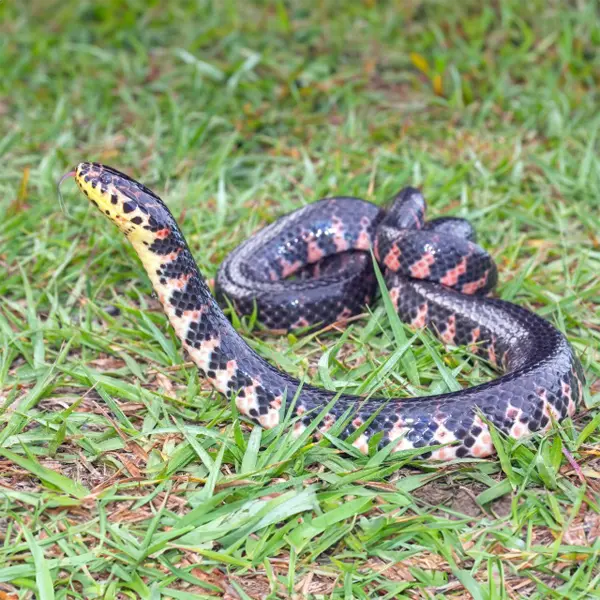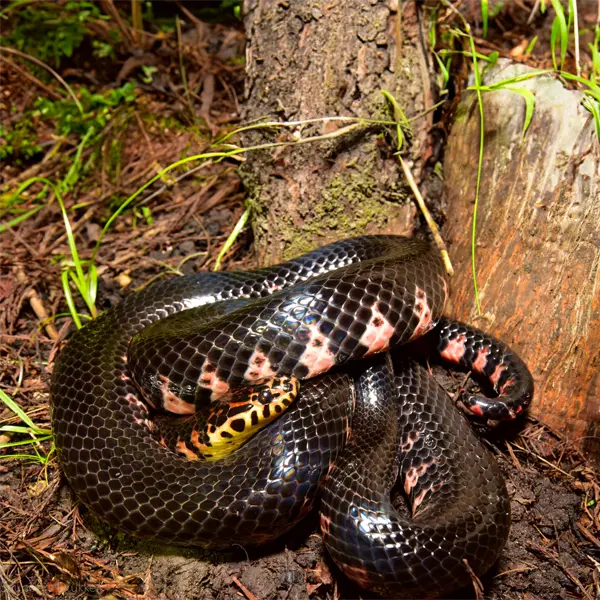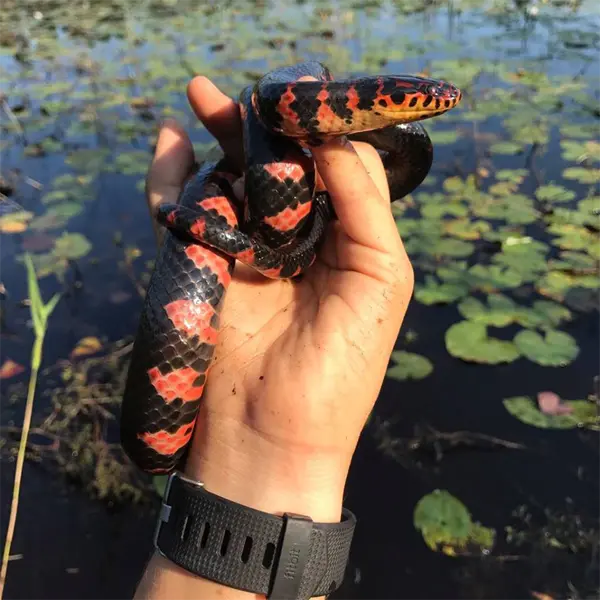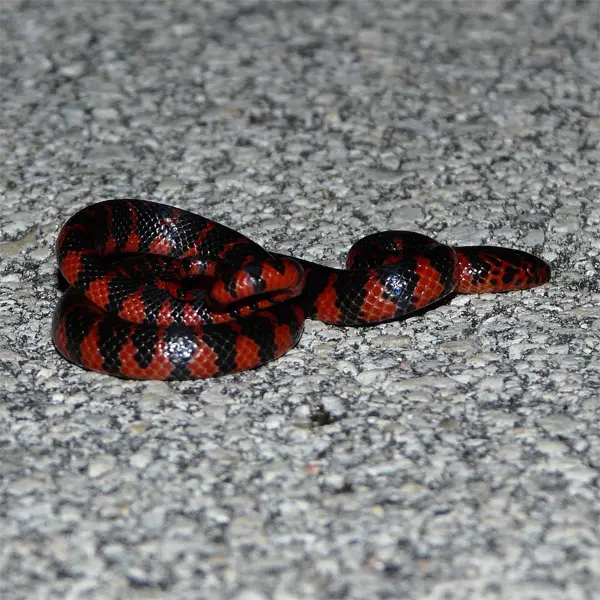Red-Bellied Mud Snake
- Scientific Name
- Farancia abacura
- Also Known As
- Mud Snake
- Range
- All of Florida
- Diet
- Fish, Crustaceans, Amphibians
- Life Expectancy
- 5 - 10 Years
Quick Links
Red-Bellied Mud Snakes in Central Florida
The red-bellied mud snake (Farancia abacura) is a harmless, semi-aquatic colubrid species indigenous to the southeastern United States. As their name denotes, these snakes possess a distinctive red ventral surface visible when threatened. Red-bellied mudsnakes thrive in Central Florida’s subtropical climate and wetland ecosystems.
This guide provides detailed identification characteristics, natural history facts, ideal habitat conditions, diet, and prevention tips regarding red-bellied mudsnakes inhabiting Central Florida.
Appearance and Identification
Red-bellied mudsnakes can be identified by the following juvenile and adult morphological features
Red-bellied mudsnakes can be differentiated from the closely related rainbow snake by their divided anal plate and lack of orangish dorsal stripe. Their pinkish-red venter separates them from plain-bellied water snakes which lack ventral coloration.
Maturation Rate
The red-bellied mudsnake exhibits rapid juvenile growth rates. Hatchlings emerge from their eggs at only 8-10 inches in length. Within the first year, they more than double in size, reaching 16 inches or more. Growth continues at a pace of 5-8 additional inches per year until full adult dimensions are attained.
Maturation is closely tied to body size. Once adult lengths of 2-4 feet are achieved after 2-3 years, sexual maturity commences. By their third spring, male red-bellied mudsnakes begin seeking receptive females to mate with. Females of breeding age also perform courtship rituals including releasing pheromones. The mudsnake’s rapid maturation enables it to produce offspring soon after reaching adult dimensions. This accelerated development is key to sustaining populations of this short-lived wetland species.
Habits and Behavior
Red-bellied mudsnakes are mostly crepuscular and nocturnal, active during dawn, dusk, and nighttime. They spend much of their time partially submerged in muddy bottoms of wetlands and stream edges. If threatened, they emit a foul musk and may writhe and expose their red belly as a warning.
Red-bellied mudsnakes are non-venomous and generally docile. They rarely bite if handled but should not be harassed. Their first defense is to flee to water and bury themselves in mud or vegetation. These snakes are excellent swimmers and can remain submerged for over 20 minutes.
Reproduction and Lifespan
Red-bellied mudsnakes reach reproductive maturity by 2-3 years old. Breeding occurs from March through May. Females lay clutches of 4-22 eggs in early summer hidden under logs, stumps, or damp soil. Eggs incubate for 60-90 days before hatching in late summer.
Hatchlings grow rapidly and are independent immediately. Lifespans in the wild average 5-10 years. Captive longevity can exceed 15 years.
Ideal Habitat and Range
The climate and habitats of Central Florida provide optimal environmental conditions for red-bellied mudsnakes. Average annual temperatures range from the upper 60s°F to low 80s°F (20-27°C). Abundant rainfall exceeds 50 inches per year, especially during the summer wet season.
These warm, humid conditions support expansive freshwater wetlands, cypress swamps, marshes, ponds, and slow streams where red-bellied mudsnakes thrive. Grasslands, scrubs, and forests also provide cover. Their fondness for mud allows them to inhabit disturbed habitats like rice fields and drainage ditches.
Central Florida’s extensive suitable aquatic habitat and prey availability allow red-bellied mudsnake numbers to flourish. Their secretive nature keeps them concealed from predators and humans despite substantial populations in natural areas.
Diet and Feeding
The red-bellied mudsnake is a voracious carnivore that consumes a variety of aquatic prey. Its diverse diet reflects its specialized adaptations for life in wetland environments. Using its forked tongue, the mudsnake detects prey by scent. It will submerge its head underwater to locate tadpoles, fish, and invertebrates hidden in vegetation or buried in mud.
Fish form a substantial part of the mudsnake’s diet. Small species like mosquitofish, killifish, and minnows are readily consumed. The snake will also take juvenile specimens of larger fish like sunfish and catfish if it can overpower them. Crustaceans including crayfish and shrimp are eagerly eaten as well.
Amphibians are another critical prey group. Tadpoles and aquatic salamander larvae like sirens and amphiumas are ambushed by the snake and swallowed whole. Aquatic frogs such as leopard frogs, bullfrogs, and green treefrogs are seized from the water’s edge. Red-bellied mudsnakes help regulate amphibian populations in wetland habitats.

Photo 218603290 © John Serrao, CC BY-ND

Common Health Risks
Red-bellied mudsnakes pose negligible health risks to humans. They have small, rear-facing teeth and rarely bite defensively. Mudsnake saliva contains mild anticoagulant compounds but is not medically significant.
Minor swelling or itching may result from a bite. Severe allergic reactions are extremely uncommon. No fatalities or serious envenomations have been attributed to this species. Their potential to transmit any infections is minimal.
Preventing Mudsnake Conflicts
Red-bellied mudsnakes naturally avoid contact with humans but may enter yards or structures near wetlands. Sealing foundation cracks and gaps in siding can exclude them. Trim vegetation back from the home.
If encountered, calmly allow them to retreat. Never attempt to kill mudsnakes – they are non-threatening and protected wildlife. Their presence indicates clean wetlands, so coexistence is recommended. With basic exclusion and tolerance, conflicts can be avoided.
Red-Bellied Mudsnakes in Central Florida – Conclusion
In summary, the red-bellied mudsnake is a common, harmless snake inhabiting Central Florida’s lakes, streams, swamps, and wetlands. Their secretive habits keep them hidden from view much of the time. While not encountered as often as water snakes or rat snakes, red-bellied mudsnakes play an important ecological role as aquatic predators.
With proper identification and an understanding of their natural history, red-bellied mudsnakes can be appreciated for their unique adaptations to watery environments across the region.







